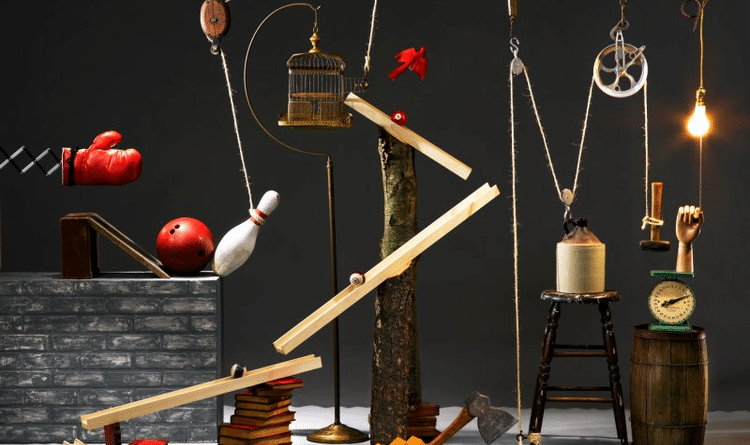Build a Rube Goldberg Machine
The concept of a Rube Goldberg is nothing new; the term was coined in 1928 by an American cartoonist whose illustrations involved completing simple tasks in overly complicated ways.
What is new is Tiktok; as of April 2020, the app had already amassed over 1 billion users worldwide. Currently, #rubegoldberg has over 401,000 views from people intrigued by the homemade contraptions moving through people’s homes, often involving ping pong balls.
However, creating a Rube Goldberg is often much easier seen than done; the machine involves lots of planning and testing to make sure the task it sets out to accomplish actually gets done.
So, instead of picking up a new Netflix show for your kid, why not get them involved in an interactive project using household objects that could even teach some physics along the way?
Here are 11 different household objects you can use to create a Rube Goldberg Machine with your kids, and just maybe keep them occupied for a few hours.
Toilet Paper Rolls or Toy Train Tracks
Ultimately, building a Rube Goldberg actually starts at the end of the machine; you’ll need to figure out what kind of goal you’d like to accomplish with your machine. After that is figuring out how you’ll get from point A to point B, which is usually going to involve some type of track. If you don’t have train tracks sitting around your house, you can build your own!
Odds are with your new toilet paper stockpile, you’ll also have a solid stockpile of the leftover rolls. They’re perfect for a rube Goldberg machine; they can transport a marble or ping pong ball just about anywhere with enough tape. Cut off the top half of the toilet paper roll if you’d like to see the action; it will also double your amount of usable stock.
If you’re using something small like a marble or even a tin foil ball, a tape measure is another option for a smooth roll. Some machines even use chopsticks or slinkies.
Old Building Blocks, Tissue Boxes, or Books
If you want your Rube Goldberg track to actually make things move, you’ll need to set the track on a slope. A great way to do this is by using old building blocks, tissue boxes, or even a pile of books to stack up a decline for the track.
In this TikTok, the creators actually used the stairs in their house to lay the track down on, but if you’re not looking to build your machine on that type of scale, anything you can pile up to build a slope should work just fine. Other designs have also set up a track to roll off a tabletop, a dresser, or even the banister on your staircase.
The options are virtually endless.
Baseballs, Ping Pong Balls, Marbles, or Just About Anything that Rolls
After you’ve built your track, put it to the test! You’re going to need something to roll through it, and might want to test a few options to see which moves the smoothest. Hot Wheels cars have proven to be a very effective contribution to a Rube Goldberg Machine, but you don’t need to limit yourself to just one!
You can use a ping pong ball for the first half of the machine to trigger dominoes, then move on to a tennis ball if you’re looking for something to move faster and hit your next point a little harder; it’s really all about planning.
This TikTok uses a ping pong ball to bounce off the bottoms of kitchen pots and pans; which makes a pretty satisfying sound if that’s something you’re looking for. Another user made himself a part of the equation.
The beauty of a DIY machine is that you can make it as simple or complicated as you’d like, or tailored to safety and learning level of your kids.
Dominoes, a Toaster, or a Fan
One of the most important elements of a successful Rube Goldberg machine is constant movement. How you trigger the movement is totally open, but creators are using everything from loaded toasters to household fans and robot vacuums.
Others have used string to either create a swinging motion (formally known as a pendulum if we’re making this project educational) or a see-saw type of motion (a counterweight system). One user even mailed a ping pong ball to his friend to keep the movement going.
Source: https://www.thomasnet.com/insights/11-household-objects-you-can-use-to-build-a-rube-goldberg-machine/
Lindsay Gilder is the Editorial Producer for Thomas Insights. She was previously the Associate Editor, and started her career at Thomas as a Supplier Content Analyst and contributing writer for Insights.
Image Credit: Getty Images

